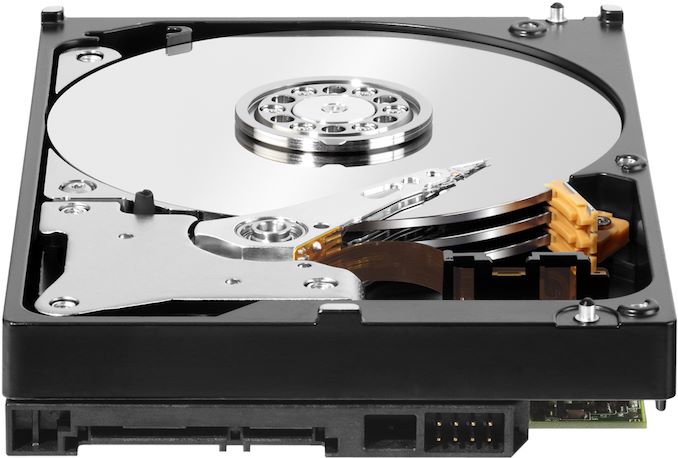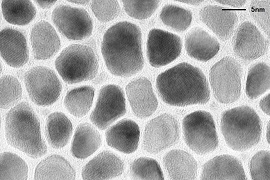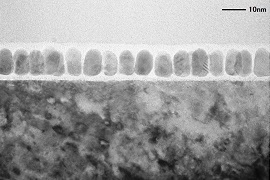The Road to 80 TB HDDs: Showa Denko Develops HAMR Platters for Hard Drives
by Anton Shilov on February 6, 2020 2:30 PM EST- Posted in
- Storage
- Seagate
- Toshiba
- Western Digital
- HAMR
- Showa Denko
- SDK
- HDD

Showa Denko K.K. (SDK) has unveiled the the company has finished the development of its next-generation heat assisted magnetic recording (HAMR) media for hard drives. The platters use all-new magnetic thin films with a very small crystal grain size in order to maximize their areal density, with the goal of eventually enabling 3.5-inch HDDs to be built with capacities of 70 TB to 80 TB.
SDK’s platters for HAMR HDDs use glass substrate and feature thin film magnetic layer made of an Fe-Pt alloy. To improve the magnetic coercivity of the media by several times over existing platters, Showa Denko used a new structure of magnetic layers and implemented new ways of controlling the temperature of the media during production.
UPDATE 2/21: As it turns out, Showa Denko will use glass substrates for platters designed for HAMD hard drives because of their superior heat resistance.
Driving these developments, it's critical to maximize the magnetic coercivity of next generation HDD platters because the crystal grains used to record data are getting extremely small. This has made them very easy to magnetize, but it has also reduced the strength of the individual magnetic signatures, which creates an unwanted magnetic inter-track interference (ITI) effect that makes it harder for HDD heads to read the data. Platters with high magnetic coercivity require energy assistance during writing and this is what energy assisted magnetic recording technologies (HAMR, MAMR, ePMR, etc.) are all about. Meanwhile, the platters must survive extreme temperatures they are subjected to during heat-assisted recording. According to Showa Denko, its new HAMR platters offer the industry’s highest read-write characteristics and durability.
Transmission Electron Microscopy Images of HAMR Media
Plain View Cross Section
SDK is not disclosing the recording density of its new platters nor are they making specific promises about when it intends to start mass production of next-generation disks. Meanwhile, the company notes that today’s leading-edge conventional magnetic recording (CMR) platters feature recording density of about 1.14 Tb/in2 and it is widely believed that this is not going to grow significantly without using energy assisted recording methods. By contrast, Showa Denko believes, HAMR-based media will achieve areal density of 5-6 Tb/in2 in the future, which will increase capacity of hard drives by several times, all the way to 70 TB – 80 TB per 3.5-inch drive without increasing the number of platters. For comparison's sake, today’s 16 TB CMR (PMR+TDMR) HDDs use nine disks, so increasing their density by ~5.2X would enable drives featuring capacities higher than 80 TB.
Showa Denko is the world’s largest independent maker of platters for hard drives, selling media to all of the HDD producers. That said, the large manufacturers — Seagate and Western Digital — also produce media themselves and tend to use their own leading-edge platters to cut costs and maximize product margins. So it will be interesting to see which of three remaining hard drive makers will be the first to use HAMR platters from Showa Denko.
Seagate will be the first company to adopt HAMR for commercial 20 TB drives in late 2020, but since Showa Denko now only plans to ‘make preparations for full-scale supply of the new HD media’, it is likely that the first HAMR drives will use Seagate’s own platters. Toshiba is expected to use Showa Denko’s 2 TB MAMR platters for its 18 TB HDDs that are projected to arrive later this year, but in the longer terms it will switch to HAMR (we have no idea when). By contrast, Western Digital uses its so-called energy-assisted PMR (ePMR) technology for its 18 TB and 20 TB HDDs due this year and will gradually move to MAMR and HAMR in the years to come.
Related Reading:
- Toshiba's HDD Tech Roadmap: A Mix of SMR, MAMR, TDMR, and HAMR
- 18 TB HDDs: Toshiba Collaborates with Showa Denko for MAMR HDDs
- HOYA Starts to Build Next-Gen HDD Glass Substrate Production Facility
- Seagate: 18 TB HDD Due in First Half 2020, 20 TB Drive to Ship in Late 2020
- Western Digital Roadmap Updates: Energy Assisted Recording, Multi-Stage Actuators, Zoned Storage
Source: Showa Denko












75 Comments
View All Comments
prisonerX - Thursday, February 6, 2020 - link
Most technological developments will be obsolete in 10 years time. You're assuming that spinning platters won't progress in those 10 years, just like they have every other 10 years since inception their inception. Ans they'll do so in a way that satisfies their niche.DanD85 - Thursday, February 6, 2020 - link
Lol, I guess you've never heard about data tape then? 80TB hard drive? Magnetic tape has reached 330TB since 2017! Every storage technologies have its own places.MrSpadge - Thursday, February 6, 2020 - link
Cramming lot's of NAND in a tight space is not an issue, but paying for all those chips is. And yes, you can increase the cold storage time - at the cost of capacity. You have to go back to SLC, increase cell sizes and insulate them better (slower). Sounds pretty unattractive to me.Beaver M. - Friday, February 7, 2020 - link
Not to mention resources. Its easy to get materials for HDDs and recycle them. The materials used in SSDs are rare and expensive, hard to come by, limited and very hard to recycle, if not impossible.If you were an eco-activist, you would see SSDs as the big bad combustion engines.
Beaver M. - Friday, February 7, 2020 - link
I recently started up an SSD from my old 2008 machine. Hasnt been touched for 10+ years.All data is still there, everything works.
Humans are good at making an elephant out of a fly.
PeachNCream - Friday, February 7, 2020 - link
Humans are also pretty good at comparing apples to oranges (older, larger feature size MLC tolerance applied as if it were modern, smaller TLC).Humans further excel at assuming a sample size of one is statistically significant (my one computer passed a cursory check so everyone will have the same outcome).
Humans are really good at making up fictional situations which no one can disprove in order to make a false point (a supposed computer from 2008 that has not been turned on in 10+ years).
Beaver M. - Saturday, February 8, 2020 - link
Humans are also good at making shit up. I even know people who still claim that SSDs are far too unreliable because they break early because of the write limit. :)Humans are also good at reading too much into a sentence they didnt read properly. I only said its from my 2008 machine. Never said its still here. The SSD was outside all this time, not connected at all for at least 10 years. Funny thing is that I had a 40 GB HDD that is a little older, and wasnt connected all that time either and that one isnt working anymore.
Many examples like mine in forums and even articles about it. If you dont believe it then you are a very human human. :)
And thats not even my fault. Gasp, huh?
PeachNCream - Sunday, February 9, 2020 - link
I like the goal posts that you've just moved to make your story seem more plausible. It's a good try and you should give yourself a sticker for the effort.MASSAMKULABOX - Friday, February 7, 2020 - link
Its pretty shocking to me that these are *mechanical* drives operating almost at the atomic scale. And they are expected to endure a pretty hefty duty cycle. What do they use on the ISS .. gotta be hardened SSD's (maybe just 28nm or bigger?). The takeoff alone would destroy any unparked HDD's?. Who would have thought HDD's would still be going strong after SSD's emerged 20 years ago.valinor89 - Friday, February 7, 2020 - link
They used ThinkPads and mention using hard drives.https://www.ibm.com/ibm/history/exhibits/space/spa...